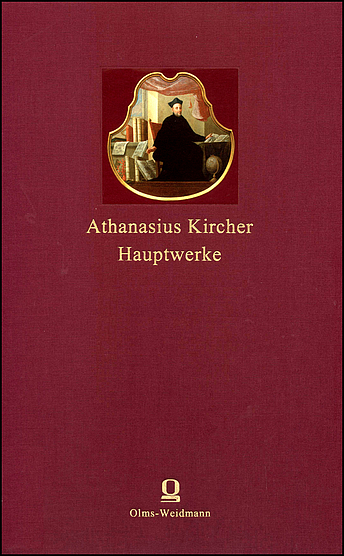Eusterschulte | Breidbach | Schmidt-Biggemann
Athanaius Kircher: Hauptwerke
ISBN 978-3-487-14655-3
englischThe "Musaeum Celeberrimum", edited by Giorgio de Sepi, is a special treasure within this edition of the works of Kircher. In an impressive way the catalogue documents the systematics and collections as well as the practice-oriented structure of the famous museum set up by Kircher at the Collegium Romanum. The Musaeum Kircherianum ‘embodied’ the concept of universal scientific, encyclopedic knowledge. It presented naturalities, curious natural phenomena and miracles of nature as well as technical instruments, apparatuses or ethnographical and cultural-historical objects, gems, relics, raras. It included manuscripts, books, inscriptions, coins but also art and cult objects, archaeological items, architectural fragments, models as well as a lot of amazing material testimonies from the ‘old’ and ‘new’ worlds. It presented this knowledge from natural and cultural history in a systematic order and made this cosmos of learned knowledge tangible, even accessible and thus experienceable. Visitors could witness scientific experiments. In the wide halls, through which Kircher has often guided his guests, the analogy of micro- and macrocosms became present. At the same time the museum represented the worldwide knowledge network and missionary activity, thus the political claim of the Jesuits in Rome. Finally, the museum is also a kind of ‘portrait’ of Kircher’s life’s work and an expression of his self-understanding. His self-biography shows how Kircher’s path of life and his scientific impact are communicated.
Equally in his "Vita" (justly entitled "Selbstbeschreibung", not "Autobiographie", by an earlier translator) we encounter Kircher as an old man who now, in retrospect, recreates episodes of his early years using hagiographic patterns recurrent in lifes of main saints of the church like the Aquinate and the founder of the Jesuit order.
Kircher presents us with his pious fidelity as the main feature of his complex personality, instead of emphasizing his stupendous curiosity and erudition. He had no doubts whatsoever, that the virgin Mary gave him an aim in life and a vocation and had intervened repeatedly in his favour.
The Latin text, published shortly after Kircher’s death and staying virtually unnoticed, can now be read critically edited together with a German translation, some explanatory notes and a short introduction highlighting the aforementioned hagiographic patterns.
The introduction to the "Musaeum Celeberrimum" opens up Kircher’s collection concept with regard to media of knowledge representation and its cultural-historical context. The translation of the self-biography and the introduction give an insight into the self-conception of the Jesuit universal scholar within baroque knowledge cultures.
Das von Giorgio de Sepi herausgegebene "Musaeum Celeberrimum" ist eine besondere Kostbarkeit im Kontext Ausgabe der Werke Kirchers. Handelt es sich hier doch um einen Katalog, der auf eindrucksvolle Weise die Systematik und die Sammlungsbestände aber auch den praxisorientierten Aufbau des weltweit berühmten, von Athanasius Kircher im Collegium Romanum eingerichteten Museums dokumentiert. Das Musaeum Kircherianum verkörperte geradezu das universalwissenschaftliche, enzyklopädische Wissenskonzept. Es präsentierte Naturalien, kuriose Naturphänomene und Wunder der Natur. Es stellte technische Instrumente und Apparate ebenso zur Schau wie ethnographische und kulturhistorische Gegenstände, kostbare Kleinode, Reliquien, Rara. Es umfasste Manuskripte, Bücher, Inschriften, Münzen ebenso wie Kunst- und Kultobjekte, archäologische Gegenstände, architektonische Fragmente, Modelle und nicht zuletzt staunenswerte materiale Zeugnisse aus den ‚alten' und den ‚neuen' Welten. Aber es führt diese Wissensobjekte und -dokumente aus Natur- und Kulturgeschichte nicht nur in systematischer Ordnung vor Augen. Es macht einen Kosmos gelehrten Wissens greifbar, ja begehbar und schließlich erlebbar, denn Besucher konnten in Laboren Zeugen wissenschaftlicher Experimente werden. In den weiten Hallen des Museums, durch das Kircher seine Besucher oftmals persönlich geführt hat, wird die Analogie von Mikro- und Makrokosmos erfahrbar. Gleichzeitig repräsentiert das Musaeum Kircherianum das weltweite Wissensnetzwerk und damit auch den politischen Anspruch der Jesuiten und ihrer Missionstätigkeit. Schließlich ist das Museum auch eine Art Portrait des Lebenswerks Kirchers und damit Ausdruck seines Selbstverständnisses. Wie sich Lebensweg und wissenschaftliches Wirken des Universalgelehrten vermitteln, zeigt die in diesen Band eingebettete Neuübersetzung der "Selbstbiographie".
Auch in der Vita (von Nikolaus Seng 1901 richtig unter dem Titel Selbstbeschreibung übersetzt, denn von einer Autobiographie kann kaum die Rede sein) begegnet uns der alternde Kircher, der hier rückblickend Episoden aus der Jugend und seinen Jahren als junger Mann mit hagiographischen Mustern überblendet, die an großen Heiligen der Kirche wie Thomas von Aquin und Ignatius von Loyola Maß nehmen.
Nicht als Gelehrter präsentiert er sich, sondern als ein frommer Christ, der felsenfest davon überzeugt ist, dass wiederholte Interventionen der Jungfrau Maria seinem Leben Berufung und Ziel gegeben haben.
Der erstmals 1684 posthum erschienene, wenig beachtete Text wurde für diese Ausgabe kritisch ediert und durch die gründlich überarbeitete Übertragung Sengs ergänzt.
Die Einleitung zum "Musaeum Celeberrimum" erschließt Kirchers Sammlungskonzept in Hinsicht auf Medien der Wissensrepräsentation und ihren kulturgeschichtlichen Kontext. Die Übersetzung der "Selbstbiographie" samt Einleitung geben Einblick in das Selbstverständnis des jesuitischen Universalgelehrten innerhalb der Wissenskulturen des Barock.


